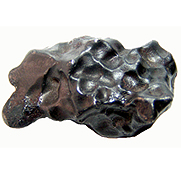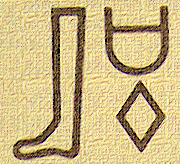Iron Hearts

Enlargement
The surface of the iron meteorite Sikhote-Alin is covered with a shiny fusion crust and regmaglypts, also called thumbprints. |
Iron meteorites are made up almost exclusively of metal. This metal is mainly iron, with a variable proportion of nickel, as well as traces of germanium, gallium, iridium, and tungsten. Iron meteorites contain two iron-nickel alloys, kamacite and taenite.
There are three types of iron meteorites, which have different structures depending on how much nickel is combined with the iron. Hexahedrites contain little nickel (4.5 to 6.5%)-their main alloy is kamacite. Hexahedrites show no structure except for many fine, parallel lines called Neumann lines. Octahedrites contain between 7 and 13% nickel-both kamacite and taenite are present, fitting together to form impressive structures called Widmanstätten figures. Octahedrites are classified according to the width of the kamacite bands. Ataxites contain between 13 and 25% nickel. These meteorites show no internal structure, being almost exclusively composed of taenite.
Each type of iron meteorite can be divided into 17 groups identified by numbers and letters according to how much gallium, germanium, and iridium they contain. Iron meteorites are made up of the metal that accumulated at the centre of a planetoid during its semi-liquid phase. This means that iron meteoroids come from parent bodies that have lost both their crust and their mantle.
 |
| Enlargement |
| The ancient Egyptians had a hieroglyph for iron meteorites. Because unoxidized iron is extremely rare on Earth, such meteorites were the principal source of iron for many ancient peoples. |
|